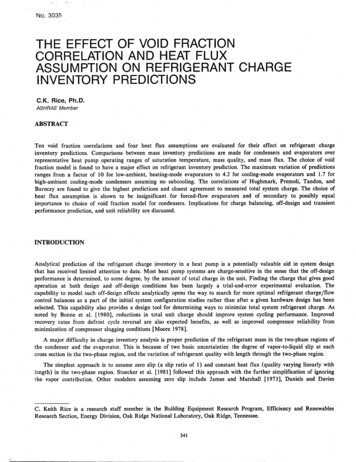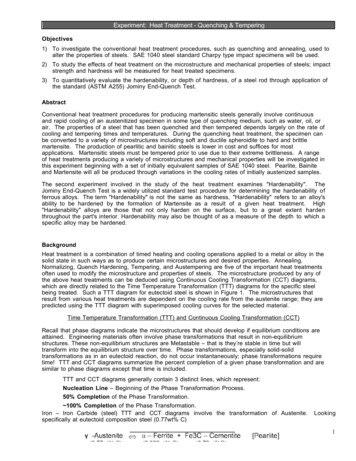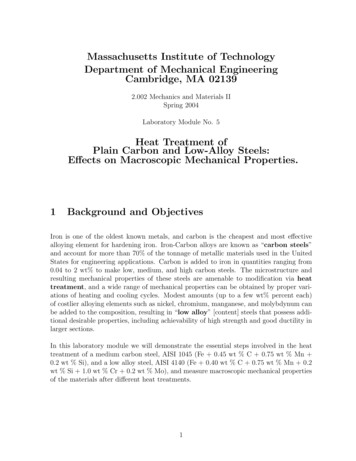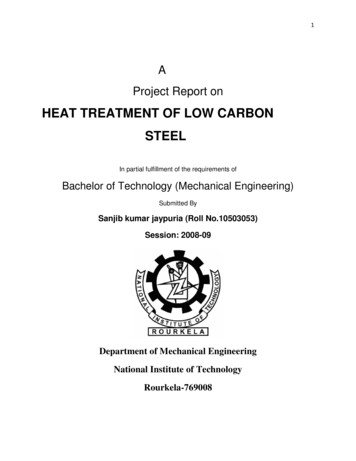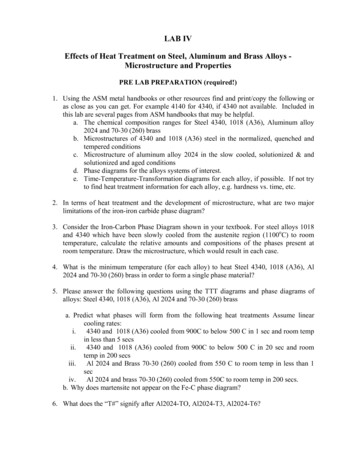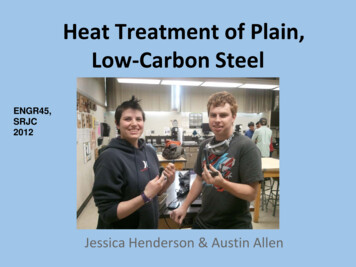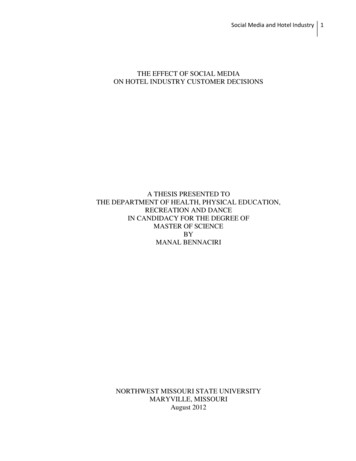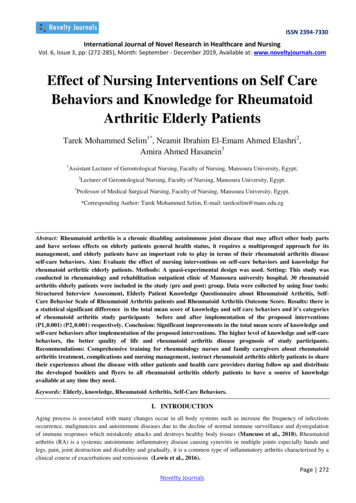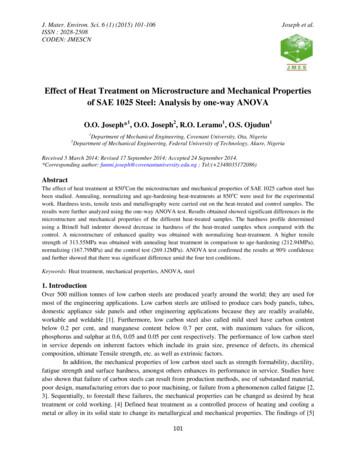
Transcription
J. Mater. Environ. Sci. 6 (1) (2015) 101-106ISSN : 2028-2508CODEN: JMESCNJoseph et al.Effect of Heat Treatment on Microstructure and Mechanical Propertiesof SAE 1025 Steel: Analysis by one-way ANOVAO.O. Joseph*1, O.O. Joseph2, R.O. Leramo1, O.S. Ojudun112Department of Mechanical Engineering, Covenant University, Ota, NigeriaDepartment of Mechanical Engineering, Federal University of Technology, Akure, NigeriaReceived 5 March 2014; Revised 17 September 2014; Accepted 24 September 2014.*Corresponding author: funmi.joseph@covenantuniversity.edu.ng ; Tel:( 2348035172086)AbstractThe effect of heat treatment at 850oCon the microstructure and mechanical properties of SAE 1025 carbon steel hasbeen studied. Annealing, normalizing and age-hardening heat-treatments at 850oC were used for the experimentalwork. Hardness tests, tensile tests and metallography were carried out on the heat-treated and control samples. Theresults were further analyzed using the one-way ANOVA test. Results obtained showed significant differences in themicrostructure and mechanical properties of the different heat-treated samples. The hardness profile determinedusing a Brinell ball indenter showed decrease in hardness of the heat-treated samples when compared with thecontrol. A microstructure of enhanced quality was obtained with normalizing heat-treatment. A higher tensilestrength of 313.55MPa was obtained with annealing heat treatment in comparison to age-hardening (212.94MPa),normalizing (167.79MPa) and the control test (269.12MPa). ANOVA test confirmed the results at 90% confidenceand further showed that there was significant difference amid the four test conditions.Keywords: Heat treatment, mechanical properties, ANOVA, steel1. IntroductionOver 500 million tonnes of low carbon steels are produced yearly around the world; they are used formost of the engineering applications. Low carbon steels are utilised to produce cars body panels, tubes,domestic appliance side panels and other engineering applications because they are readily available,workable and weldable [1]. Furthermore, low carbon steel also called mild steel have carbon contentbelow 0.2 per cent, and manganese content below 0.7 per cent, with maximum values for silicon,phosphorus and sulphur at 0.6, 0.05 and 0.05 per cent respectively. The performance of low carbon steelin service depends on inherent factors which include its grain size, presence of defects, its chemicalcomposition, ultimate Tensile strength, etc. as well as extrinsic factors.In addition, the mechanical properties of low carbon steel such as strength formability, ductility,fatigue strength and surface hardness, amongst others enhances its performance in service. Studies havealso shown that failure of carbon steels can result from production methods, use of substandard material,poor design, manufacturing errors due to poor machining, or failure from a phenomenon called fatigue [2,3]. Sequentially, to forestall these failures, the mechanical properties can be changed as desired by heattreatment or cold working. [4] Defined heat treatment as a controlled process of heating and cooling ametal or alloy in its solid state to change its metallurgical and mechanical properties. The findings of [5]101
J. Mater. Environ. Sci. 6 (1) (2015) 101-106ISSN : 2028-2508CODEN: JMESCNJoseph et al.also revealed that, amongst various heat treatment processes (hardening, annealing, normalizing,tempering, etc.), annealing causes softening of the steel followed by a resulting increase in ductility andrelief of residual stresses. It is of necessity to note that all the different heat treatment processes consistsof three stages: heating of the material, holding the temperature for a stipulated period and cooling,generally to room temperature.Previous works carried out in this regard, include the investigations of: the mechanical propertiesof 0.13% C steel after intercritical normalizing heat treatment [6]; the mechanical properties of mediumcarbon steel under different quenchants [7]; the mechanical properties of medium carbon steel in differentquenching media [8]; the mechanical properties of medium carbon steel subjected to annealing,normalizing, hardening and tempering [9]; multi-regimes of annealing temperatures on mechanicalproperties [10]; amongst others. Nevertheless, such extension in the material modification of carbon steelsrequires the investigation to analyze how low carbon steels behave under annealing, normalizing and agehardening heat treatments. This will be achieved by a statistical analysis of experimental data using theone-way ANOVA F-test. The approach of ANOVA test is based on the breakdown of the total variationwithin an experiment into variations due to each main factor, interacting factors and residual(experimental) error. This statistical tool has been recently used by many authors in various fields, forexample, analysis of the fatigue behavior of packable composites [11]; optimal designs for estimatingvariance components with ANOVA in one-way classification under non-normality [12]; application ofANOVA to image analysis results of talc particles produced by different milling [13]; and application ofANOVA to the study of thermal stability of micro-nano silica epoxy composites [14]. However, theapplication of this statistical tool for evaluating the effect of heat treatment on low carbon steels is scarce.Consequently, in this present work, a limited experimental result for investigation of themechanical properties of heat treated SAE 1025 low carbon steel is presented. In addition, the use of oneway ANOVA test for the analysis of its mechanical properties has been discussed.2. Experimental Procedure12mm SAE 1025 steel samples were machined to standard dimensions for hardness, tensile, compression andfatigue tests. The chemical composition of the steel is shown in Table 1.Table 1: Elemental composition of SAE 1025 steelElementCSiSPMnComposition 640.040.210.0197.95In order to investigate the mechanical properties and microstructure of the steel, samples were annealed,normalized and hardened using a Carbolite muffle furnace 7B9162E. Steel samples were heated to 850 oC, soakedfor 1 hour and then cooled using various media. Samples for annealing were cooled in the furnace, samples fornormalizing in air and hardening samples in SAE 40 engine oil. After these treatments, tensile and compression testswere carried out by a type W Monsanto Tensometer on samples so as to investigate their mechanical properties.Samples for metallography were prepared and etched in 2% nital and the microstructures were revealed at amagnification of X640 under an Accuscope metallurgical microscope. In addition the hardness profile wasdetermined using Brinell ball indenter.102
J. Mater. Environ. Sci. 6 (1) (2015) 101-106ISSN : 2028-2508CODEN: JMESCNJoseph et al.3. Results and Discussion3.1 Effect of heat treatment type on the microstructure of SAE 1025 Carbon steelThe microstructures of SAE 1025 steel before and after various heat treatment modes at constanttemperature (850oC) and soaking time (1hr) are presented in Figure 1.Figure 1: Microstructure of a) As-received b) annealed c) normalized d) age-hardened steel samples at850oC.The microstructure of the as-received sample showed ferrite in the grain boundaries of the acicularpearlite grains. For this reason, the microstructure of the steel can be described as having a ferriteaustenite duplex phase. Subjecting the steel to annealing heat treatment at 850oC affected the spatialdistribution of ferrite at the grain boundaries, and scales were observed to be present in ferrite (Fig. 1b).This was due to oxidation at the metal surface. On the other hand, normalizing yielded a uniform finegrained microstructure of ferrite and pearlite with large grain sizes. Furthermore, age-hardening heattreatment revealed the presence of scales more widely distributed on the metal surface and highlydispersed ferrite.3.2 Effect of heat treatment type on the microhardness of SAE 1025 Carbon steelThe results of Brinell microhardness test in quadruplicates for each heat treatment is presented in ge-hardened012345Number of testsFigure 2: Brinell hardness values for heat treated samples103
J. Mater. Environ. Sci. 6 (1) (2015) 101-106ISSN : 2028-2508CODEN: JMESCNJoseph et al.The microhardness of the steel varied with the heat treatment method. In comparison with the hardnessresults for all the heat treated samples, the average hardness of the control (as-received) sample, 185HBwas significantly high. This was followed by the age-hardened samples with 162.5HB, the normalizedsamples having 136HB and the annealed samples with 129HB. The decrease in hardness when comparedwith the control was expected for annealed, normalized and age-hardened samples.3.3 Effect of heat treatment type on the tensile properties of SAE 1025 Carbon steelThe tensile strength and yield strength of SAE1025 steel increased with annealing heat treatment at 850 oC(Fig.3). This was observed when compared with the behaviour of the as-received samples under tensileloading signifying that annealing SAE 1025 steel at the stated temperature improves its tensile strength.The normalized samples and age-hardened samples exhibited lower tensile strengths under the sameloading conditions.7000Stres -Hardening1000As received0012345Strain6789Figure 3: Stress-strain diagram showing the tensile properties of heat treated 1025 steel at 850oCULTIMATE TENSILE STRENGTH(MPa)The comparison between the properties of the annealed, normalized and age-hardened steels in respect oftheir ultimate tensile strengths and yield strengths are shown in Figures 4 and DANNEALINGAS RECEIVED167.79212.94313.55269.12Figure 4: Ultimate tensile strength of heat treated SAE 1025 steel samples104
J. Mater. Environ. Sci. 6 (1) (2015) 101-106ISSN : 2028-2508CODEN: JMESCNJoseph et al.YIELD STRENGTH AS RECEIVED69.13121.72218.07126.34AverageFigure 5: Yield strengths of heat treated SAE 1025 steel samplesAs shown in Fig. 4, the lowest ultimate tensile strength of 167.79MPa was exhibited by the normalizedsamples whereas the highest tensile strength of 218.07MPa was obtained from annealing heat treatment.3.4 Statistical AnalysisStatistical analysis using the ANOVA was performed on the results obtained in this work.ANOVA is a powerful technique for analyzing experimental data involving quantitative measurements. Itis useful in factorial experiments where several independent sources of variation may be present [15].One-factor single-level experiment ANOVA test (F-test) was used to evaluate the separate and combinedeffects of annealing, normalizing and age-hardening heat treatment methods on the tensile strength of thesteel. The F-test was used to examine the amount of variation within each of the samples relative to theamount of variation between the samples. When the F-test is applied to the ratio of Mean Square (MS) ofcolumns to MS of residual, it will indicate whether a significant difference exists between the columns (orvarious levels of a factor). The sum of squares was obtained with Equations (1) – (3) as previously usedby [15].𝑆𝑆𝑐 𝑇𝑐𝑛2 𝑇2𝑁(1)Residual Sum of Squares:𝑆𝑆𝑟𝑒𝑠𝑖𝑑𝑢𝑎𝑙 𝑆𝑆𝑡𝑜𝑡𝑎𝑙 𝑆𝑆𝑐Total Sum of Squares:𝑆𝑆𝑇𝑜𝑡𝑎𝑙 𝑥2 (2)𝑇2𝑁(3)The calculation using the ANOVA test is tabulated (Table 2) as shown.105
J. Mater. Environ. Sci. 6 (1) (2015) 101-106ISSN : 2028-2508CODEN: JMESCNJoseph et al.Table 2: Summary of ANOVA analysis for tensile strength measurementsSource of VariationSSDfMSFHeat treatment 64.641215Significance F2.611163.559As shown in Table 2, the mean-square ratio experimentally derived (13.98) is higher than the Fratio (2.61) for 90% confidence. Hence, on the basis of the above test data it can be concluded with 90%confidence that there is significant difference between the four test conditions (that is, control, annealed,normalized and age-hardened steel samples).Conclusion1.2.3.4.A higher tensile strength was obtained for the annealed samples than for the control, normalized and agehardened samples.A microstructure of better quality was obtained with normalizing heat treatment whereas a lesser quality wasobtained by age-hardening.The hardness values of the heat-treated samples were lower than those of the unheat-treated as was expected.ANOVA test confirmed the results at 90% confidence and further showed that there was significant differencebetween the four test conditions.References1. Fish P. M. Woodhead Pub. Ltd., Cambridge, (1995).2. Ajayi J. A., Joseph O. O., Oloruntoba D. T., Joseph O. O. Int. J. Metall. & Mat. Eng. 3 (2013) 85.3. Joseph O. O., Abidakun O. A., Aniyikaye A. O., Folorunsho O. O. Industr. Eng. Lett. 3 (2013) 46.4. Singh D. K., Ane Books, Pvt. Ltd., India (2011).5. Dossett J. L., Boyer, H. E. Allied Pub. Priv. Ltd, India (2006).6. Offor P. O., Daniel C. C., Obikwelu D. O. N. Nig. J. Tech. 29 (2010) 76.7. Ndaliman M. B. AU J.T. 10 (2006) 100.8. Odusote J. K., Ajiboye T. K., Rabiu A. B. AU J.T., 15 (2012) 218.9. Senthilkumar T., Ajiboye T. K. J. Min. & Mat. Charact. & Eng. 11(2012) 143.10. Al-Qawabah S. M. A., Nabeel A., Al-Qawabeha U. F. Int. J. Eng. Res. App. 2 (2012) 1550.11. Abe Y., Braem M. J. A., Paul L., Inoue S., Takeuchi M., Van Meerbeek B. Biomat. 26 (2005) 3405.12. Guiard V., Herrendörfer G., Sumpf D., Nürnberg G. J. Stat. Plann. Infer. 89 (2000) 269.13. Ulusoy U. Powd. Tech. 188 (2008) 133.14. Saavedra J.T., Naya S., Fernández M.F., Artiaga R., Beceiro J. L. Chemo. Intell. Lab. Syst. 105 (2011) 114.15. Loto C. A., Joseph O. O., Loto R. T., Popoola A. P .I. Int. J. Electrochem. Sci. 8 (2013) 11087.(2015); http://www.jmaterenvironsci.com106
Subjecting the steel to annealing heat treatment at 850oC affected the spatial distribution of ferrite at the grain boundaries, and scales were observed to be present in ferrite (Fig. 1b). This was due to oxidation at the metal surface. On the other hand, normalizing yielded a uniform fine grained microstructure of ferrite and pearlite with large grain sizes. Furthermore, age-hardening heat .

